Structures external references
Last updated: 2024-05-03
 Overview
Overview
An external reference (Xref) inserts the entire contents of another drawing into the current drawing as a display-only object. For more information about Xrefs, see the External references or Blocks and external references pages.
Requirement: Almost all drawings with external references should be using a struct-decimal-start template. For more information see the Structures drawing templates page.
 Bureau of structures reference file structure
Bureau of structures reference file structure
WisDOT only: This section is for Bureau of Structures staff only.
Bureau of Structures reference files are located in C:\BoxDrv\Box\BOS\Design\References

References are organized by Project ID so structures in the same project can share references. The latest version of each reference file should be placed in the root of the project folder. Previous versions of reference files should be placed in the Archive folder, organized by date received.


Each structure layout file is placed in its own folder within the project references folder. For more information, see the Structures layout file page.

 Attach an external reference
Attach an external reference
Requirement: All Xrefs should be attached when UCS is set to WCS. For more information see the Structures coordinate systems page.
- Rotation of view will not impact the proper insertion of the reference.
- References in LAYOUT & GEO templates are Global Coordinate Correct
- References in DETAIL templates are not globally correct (12x too small)
- Because Structure Layout files are drawn in the LAYOUT & GEO template (aka 1 unit = 1 foot), scaling up by 12 is required for proper functionality within the DETAIL template.
For more information, see the Using References in a Details Template section below.
-
Ribbon > WisDOT [***] tab > Manage panel > Xref Tools dropdown > Load Xref on Layer
For more information, see Xref tools - Load Xref on Layer.
-
Select the reference file in the Select Reference File Dialog box and click Open
Info: By default, references are loaded with relative paths, which means the reference will break if the drawing is moved without the reference. See the External references #palette section for more information about changing the path type.
 External references #palette
External references #palette
-
To access the External References palette type XREF
Alternatively, Ribbon > Insert tab > References panel > ↘ (flyout)
- The Xref palette will have the current drawing as the only reference if there are no references in the drawing.
-
If there are references in the drawing, Right-Click to pull up additional options.
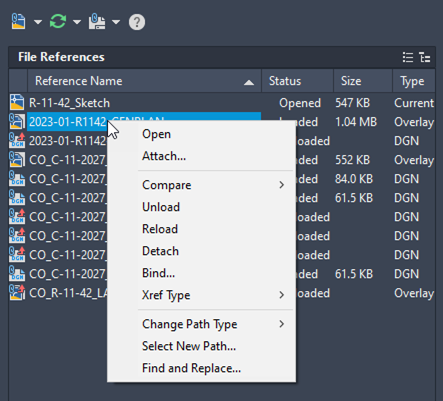
- Unload - removes the reference from the file so it is not visible and does not load when the file is opened, but is still listed in the Xref palette.
- Detach - removes the reference from your drawing and the Xref palette
- Bind... - inserts the Xref data into your drawing file, so it will be visible even if the Xref file is moved or deleted.
- Change Path Type
- Absolute references will stay attached even if you move the drawing to a different location
-
Relative references will stay attached when you move the drawing and reference together

Warning: after binding a reference, it's not possible to reattach another copy of the reference. You will need to PURGE or RENAME the bound reference first.
 Manipulating external references
Manipulating external references
- Click on an external reference in the drawing to select it. The entire Xref highlights because it is all one entity.
-
The Contextual ribbon changes to the External Reference tab.

- Xrefs scale, move, copy, rotate, etc. just like other objects using the standard commands.
-
External references can be edited using the Edit Reference in Place command.
Warning: Saving changes while editing a reference in place will save the referenced file.
 Create clipping boundary
Create clipping boundary
-
Xrefs can be clipped to clean up the drawing and reduce the linework shown within a the drawing.
Requirement:- If the final drawing will be rotated, follow the steps in the Structures Coordinate Systems page first.
- The reference layer needs to be unlocked before it can be clipped. Xrefs attached with the Load Xref on Layer tool will be locked by default.
- Create a closed shape to define the clipping boundary. This can be done using the command RECTANG or by creating a closed polyline (PLINE)
- In Model space select the Xref drawing to be clipped
-
Ribbon > External Reference tab > Clipping panel > Create Clipping Boundary

-
Type in commandline S for Select polyline.

-
Select the shape created to define the clipping boundary.
 Remove clipping boundary
Remove clipping boundary
- In Model space select the clipped Xref drawing.
-
Ribbon > External Reference tab > Clipping panel > Remove Clipping

 Xref fading
Xref fading
The XDWGFADECTL system variable controls the dimming for all DWG Xref objects. It can be set to 0 for no fading up to 90 for 90% faded.
-
Ribbon > Insert tab > Reference panel pulldown > Xref fading
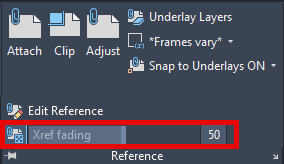
-
Use the slider to control the fading percent.
Info: The Xref fading controls how Xrefs appear in the drawing, but it does not change how they print.
 Xref ghosting
Xref ghosting
Xrefs come in "faded" by default, causing them to appear as dark gray in a viewport. This does NOT mean it will plot gray. Use the following steps to change the plot color of an Xref.
- In a Sheet Layout, double click inside a viewport to enter it and make changes.
- Ribbon > Home tab > Layers panel > Layer Properties
-
Select the Xref filter to choose all Xref layers, or select the specific Xref to change.
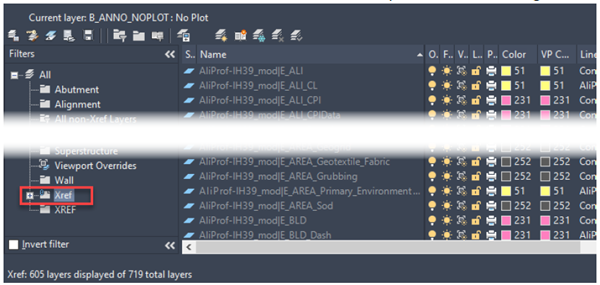
- Select all the layers in the layer list: Ctrl+A.
-
Click on the VP Color option of one of the layers.
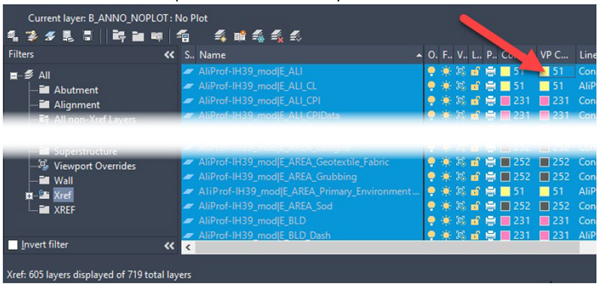
-
Change the color to 253 or any other plot color that will print the desired shade of gray.
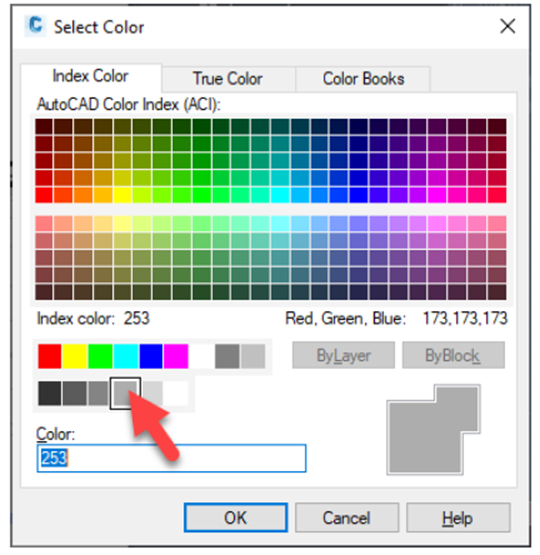
Info: For more information about plot colors, including information about different shades of gray, see the Structures template plot colors page.
- OK
-
-
Plot or Print Preview to view the changes.
 Using references in a details template
Using references in a details template
- ATTACH a Structure Layout file as an Xref (and alignment or other references if desired).
- INSERT North Arrow block near structure for reference.
- Use the COPY command to duplicate the Xref.
- Use the SCALE command to scale the Xref up by 12
- Use the MOVE or ROTATE commands as needed to position the scaled up copy of the references where desired.
 Xrefs with surfaces
Xrefs with surfaces
When working with some files from roadway, they may contain surfaces with broken lines. Follow the steps below to remove them.
- Open the roadway file.
- Ribbon > Home tab > Pallets Panel > Toolspace
-
Drill down in the tree where the warning sign is, Right-Click on the surface, and choose Repair Broken References...
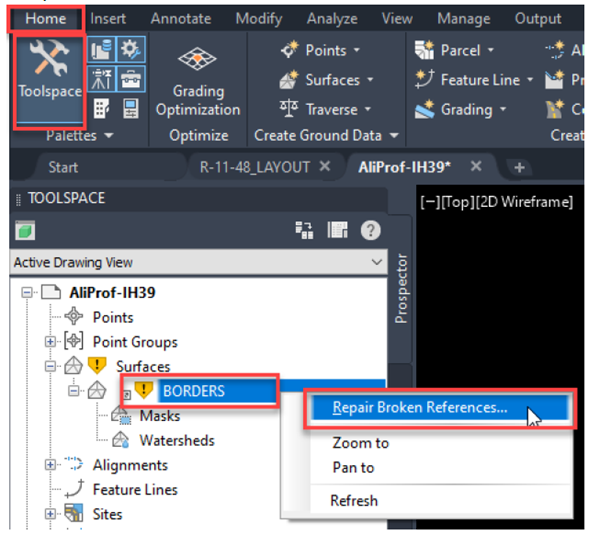
-
An Open dialog box will show up. Cancel

-
A warning window should pop up. Delete the reference
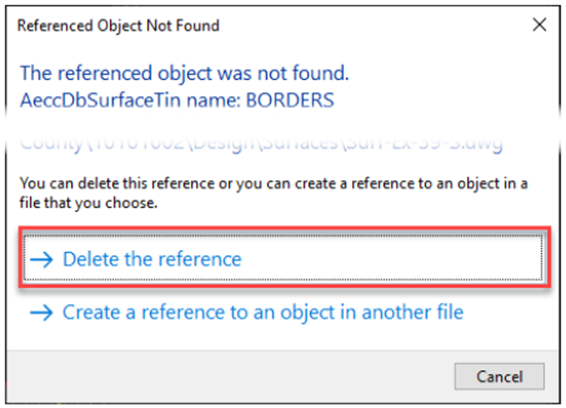 x
x - Save and Exit.